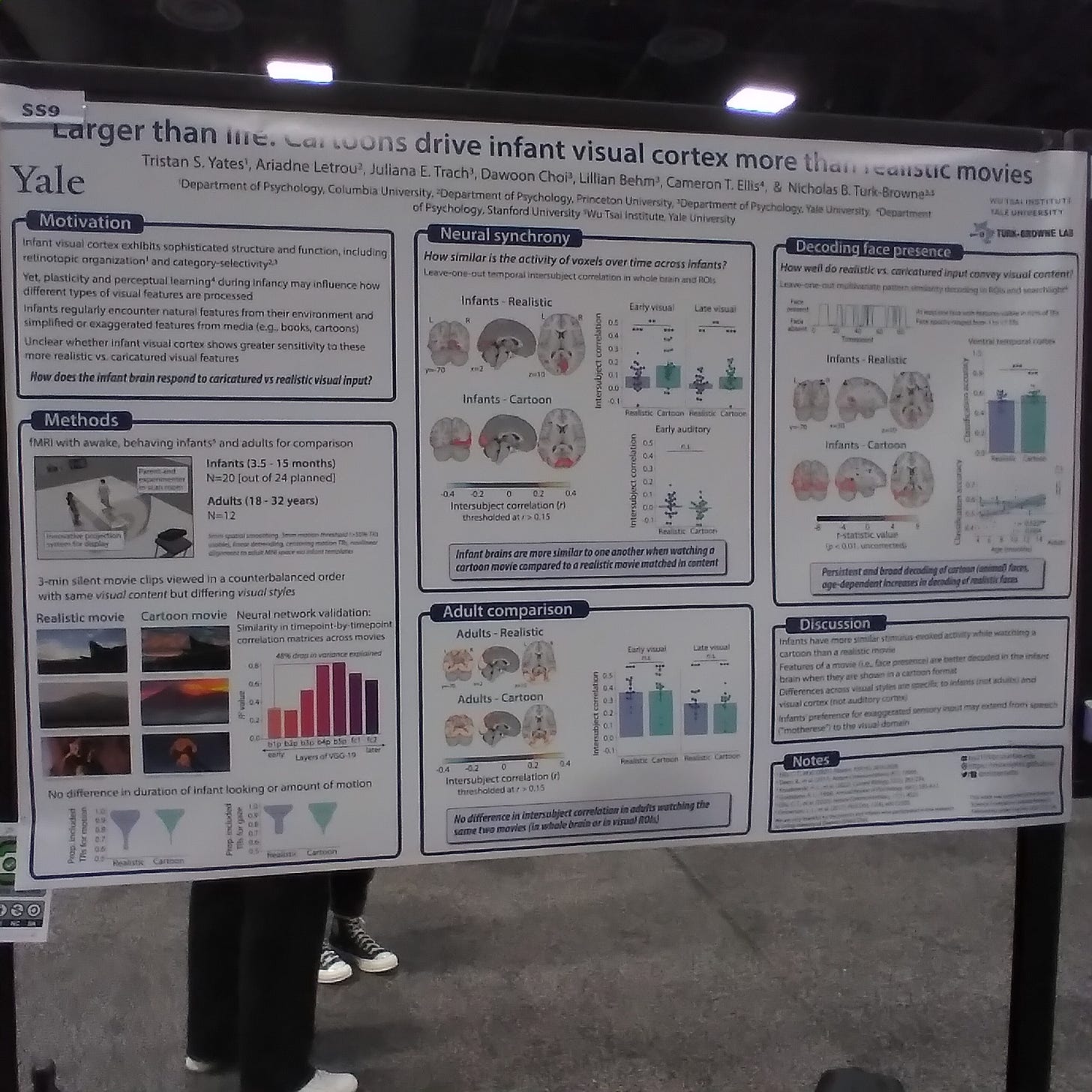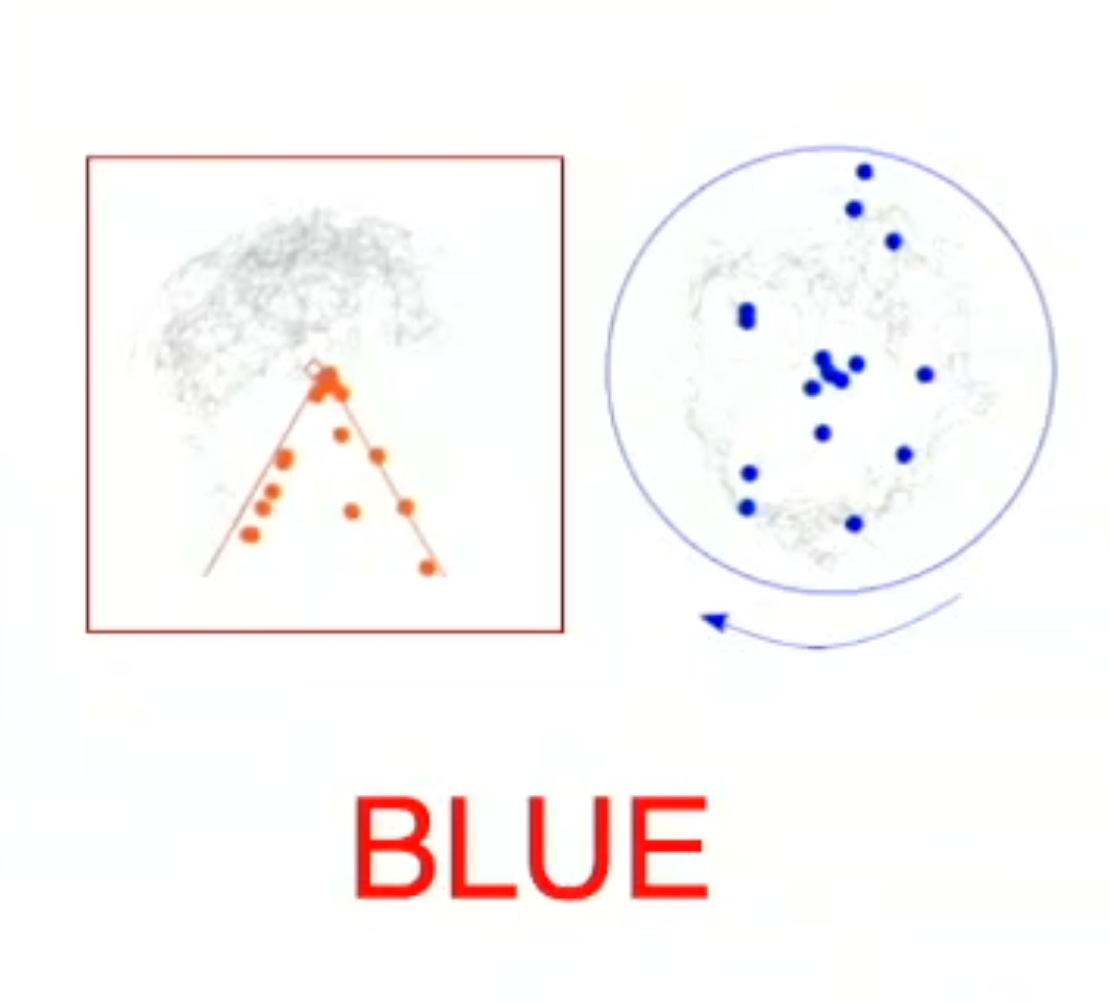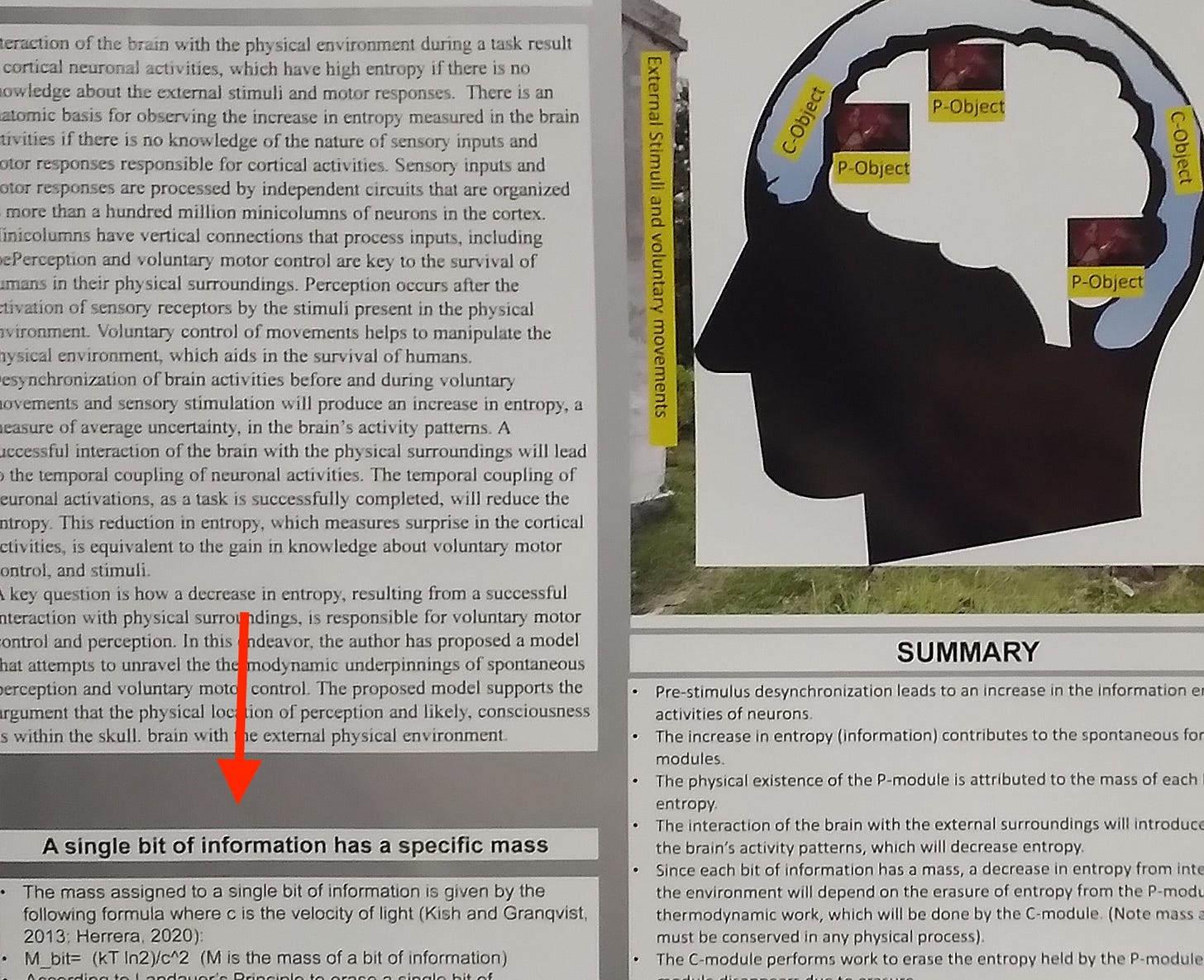Highlights from SFN
SFN is a huge neuroscience conference, drawing in scientists from all over the world, and I attended it for the first time in November.
Background context
Science conferences have three parts: (1) talks, (2) vendors trying to sell you cool-but-expensive stuff, and (3) posters.
Posters are put up by grad students to represent their thesis projects1. There’s a four-ish hour period where they’re required to stand next to their poster and answer questions from anyone who wanders by.
My sister-in-law described this as “so basically a science fair for adults”, which is… spot-on, actually.

Highlights
The thing I’m going to remember most from SFN 2023 is the poster presentation arguing that magnetism is God. It didn’t say so in quite so many words, but it came close. The basic idea was that life wouldn’t be possible without Earth’s magnetic field (true), so magnetism created life (false). Magnetic and electric fields create each other (mostly true), and the brain uses electrical signals (true), so there is a “bidirectional force” exerted by our brains and the geomagnetic field on each other (uhh…technically…maybe?), and this “might explain the power of prayer” (just no)2. I argued back that air temperature and gravity were also “bidirectional forces” between us and the Earth, and just as meaningful/meaningless as magnetism. It was a fun conversation, and I mean that not sarcastically.
Just to re-establish SFN’s reputation as a highly prestigious scientific event, let me point out that one of the speakers referred to the following, without a hint of sarcasm, as a “very simple equation”.
If you want to know what not-simple math at SFN looks like, the answer is “fractional derivatives”. If you took calculus, you might remember having a function like f(x) = x3 and finding that the first derivative is f’(x) = 3x2 and the second derivative is f’’(x) = 6x. Fractional derivatives are what you do if you want to take, say, a 1.5 derivative.
Apparently, if you can figure out what that means, it’s useful for making a brain model that allows both slow and fast learning to progress at the same time.
“Don’t worry,” the poster guy assured me. “Basically no one in neuroscience is familiar with this kind of math.”After the magnetism-is-God poster, my next favorite moment in the conference was this one, during a Q&A after the speakers’ slideshows had been put away3.
Cracks me up, every time I re-listen.
Mad science headline: Brain cells grown on a computer chip learn to play Pong (science paper, media reporting). This is (literally) last year’s news, but I only discovered it because of one of the posters at SFN. Some scientists grew neurons on a computer chip so they could measure the electrical signals passing through the neurons. The neurons in particular zones were designated as “muscles”, and the Pong ball was moved depending on how they activated. Feedback was sent back to another zone designated as “sensors”. After 5-10 minutes of playing, the cells were making noticeably more “hits” than untrained cells.
Now you know that the number of brain cells it takes to play Pong is less than the number that fit on a computer chip.
One of the talks presented a new technique where you put a special molecule into the membrane of a neuron, then attach a second molecule to your first one, and when an electrical signal passes through the cell, the first molecule changes shape in a way that makes the second one start glowing.

This is my own not-at-all-how-it-really-looks picture of what’s going on. A signal passes along the membrane, pushes the green springs together, making a connection on the light bulb, which then lights up. If you scatter these across the brain4, you can then look at it and watch the electrical signals traveling through neurons, by the pattern of glowing. They named this method Voltron, which is appropriate, as it’s about the coolest thing I have ever heard.
In another “crazy things that scientists do” experiment, one group forced induced human stem cells to grow into a mass of human brain tissue called a “brain organoid”, injected this with a virus that forced all the cells to make a label-protein, then implanted the organoid into a mouse brain. Their label-protein let them be sure, when they imaged the brain, whether they were looking at original mouse neurons or human neurons. At first, the human neurons just showed random firing patterns, but over time, they started showing the patterns that indicated they were being integrated into the mouse’s normal brain processes.
Next step: inject more neurons into my brain, and find out if I become smarter.If you feel bad for mice, do not become a neuroscientist. At one point I realized I was walking by poster after poster describing things like this:
“To activate PV cells, we optogenetically stimulated Channelrhodopsin-2 in transgenic PV-cre::Ai32 mice through a cranial window chronically implanted over V1, with levels varying between 0-0.43mW/mm2.”
Translation: We put microbe genes into mice embryos, grew them into mice, cut holes in their skulls, and let them walk around with devices attached to their heads that would force neurons to fire whenever we wanted.
This quote was a wait, what? moment for me:
“We're going to take our conductance that we recorded in vivo, and inject it in vitro, using this technique called dynamic clamping.”
Translation: We’re going to record electrical jumps in a living brain, then inject these into a slice that we’ve removed from a brain, to see if the neurons respond the same way the did in the brain.
This makes as much sense as injecting a cell phone signal into your bloodstream. It’s not that it’s mad science; it’s that the underlying concepts don’t match up.But it turned out that when they said “inject”, they meant “attach electrodes and stimulate the same electrical jumps”, which made sense just fine.
Moving to the opposite end of the mad scientist spectrum, this is a very scientific poster asking why kids like cartoons.
Seen on a poster:
“Subspace rotations co-occurred with traveling waves in spike rates. Removing rotational subspace components from activity reduced traveling wave structure.”
I can’t help but notice that “subspace rotations” is the most Star Trek thing to be said, ever.
I made a note to myself to look up what subspace rotations were. After looking over the poster, I am 70% sure that it’s a math analysis thing, and does not, in fact, involve brains or anything else physically rotating. Unlike this poster about dancers:
In addition to being on the cool topic of dancers, this poster also says, “In contrast to our hypothesis, dancers with the best balance had the largest N1 amplitudes.” I have no idea what an N1 amplitude is, but the authors get 200 science points each for admitting they found their hypothesis not to be true.
Nevermind N1 amplitudes, PV-cre::Ai32 mice, subspace rotations, or fractional derivatives: the single most confusing thing I saw at SFN was this:
I know what the top part means: a mouse was put on a rotating platform, and if it entered the triangle [locations marked by orange/red dots], shocks would be administered in a scattered way across the platform [marked by blue dots].
But why is “blue” written underneath? What is that supposed to convey?
And worse, why is it written in red?!
I was walking past a poster when one of the headings caught my eye.
Wait, what? Information doesn’t have mass. That doesn’t make sense. But there’s an equation involving the speed of light there? I made a note to come back and look at it again later.
And now, having done that, I can provide you with the following quotes [my emphasis]:
The author proposes a hypothetical informational object situated within the skull, called a P-module, depicted as a demon in the schematic.
… This cycle of creation and erasure of P-modules would help to maintain P- and C-modules [C - consciousness], which may be correlated with external surroundings via quantum entanglements forming the basis of awareness (???) of surroundings.I didn’t add that “(???)”; that’s in the poster. Probably it’s the author’s innocent acknowledgment of something unproven, but given that trying to link quantum anything to consciousness is a big red flag, I can’t help but read it as a meta statement: if you need more than one question mark to express yourself in a science paper, maybe you should ask yourself if you’re really doing science.
Also, his university association is a “School of Pharmacy”, and two of his three cited “publications” are editorials that he wrote5.One spicy poster found that “meth increases neurite length and density of dendritic spines in the Ca1 region of the hippocampus of WT mice”. Translated from neurosciencese, this means: meth…increases capacity for learning and memory? I guess that’s to be expected; a mild, temporary boost in cognition just doesn’t make up for the terrible addictiveness and withdrawal effects.
Another poster had the spicy title, “Effects of Hormonal Contraceptives on Dendritic Spine Density in the CA1 Region of the Hippocampus”. Again, this translates to “How much do contraceptives affect ability to learn and remember?” The answer is that, for mice, contraceptives put them in the middle between the two extremes that happen at different hormonal phases. Which makes sense, since contraceptives level those hormones out.
Another “that makes sense” poster:
The nutshell is that math anxiety corresponds with poor spatial visualization and poor working memory. In retrospect, this is obvious: if you have trouble visualizing “384 + 811” on a mental chalkboard, or if you can’t store enough extra digits in your working memory at a time, that will make the problem harder to do, which will make you anxious.
During a description of the limitations of the patch-clamp technique:
“Eventually the cell will die, because you put a hole in it.”
There’s a hypothesis called SHY that says synapses grow more when you’re awake, and get pruned down when asleep. One poster presented a new hypothesis called WISE, that says it’s the other way around. He has a computer simulation to support the claim, but hasn’t done physical tests yet. I am amused at the idea of someone sitting around, thinking “Here’s this existing theory, but let’s try saying it’s the exact opposite of that and see what happens.”
Some of the humor came closer to home. And by that, I mean that it came from my boss, who is going by Aurelia now that she’s … well, a she.
Other person: “You’re just walking around with rat brains in your pocket?”
Aurelia: “Yep.”
Other person: …
Aurelia: “I just kinda poured the brain sample out into [the vendor’s lightsheet microscope]. No one had a petri dish, so I bummed a coffee cup off someone and ripped it to the right size.”In any gender, my boss is a character.
Some of the humor came literally from my home. SFN happened in Washington, D.C. Meanwhile, I live in Oregon. I was thus on the opposite side of the country when I got this text from my 19yo son6.
On the topic of D.C., let me just say that DC drivers are terrible. I mean really, truly awful. They say every city thinks its own drivers are the worst. Well, I nominate DC as the worst.7
Getting back to the neuroscience, several speakers made reference to “heroic experiments” by their grad students, and now I want to know what qualifies for a heroic experiment8. Probably the real answer is “sheer tediousness”, but I’m going to imagine that it involves lifting gorillas with one hand or channeling electricity directly into neurons with your fingers.
Somehow, both times that I sat to lunch in the crowded cafeteria and started a conversation with a random tablemate, the person’s specialty turned out to be traumatic brain/spine injury. You will be happy to know that if you get your head bashed in sometime, you are not more likely to end up with Alzheimers. And if you have a spine injury, you may not be able to walk, but your cognition is just fine.
After mice, the second most popular animal to do neuroscience on is a fruit fly called Drosophila, because they’re easy to breed or something. In 2018, the first complete electron microscope images of a fly brain were made. There are automated programs to turn the 2D pictures into a 3D map, but they tend to be glitchy. It took 500-ish humans—a collaboration of Drosophila teams from around the world—three years to proofread and fix the final map. And that’s for a brain that fits inside a tiny fruit fly. Imagine doing that for a whole human brain.
Apparently male drosophila flies attract mates by buzzing their wings—in what scientists naturally call love songs. You can hear the hum-buzz-hum-buzz pattern here:
Another fact that I learned is that it’s really hard to concentrate on reading when someone nearby has a loud or penetrating voice.
This surprised me. I tune out my kids and other noise all the time. I find words on billboards distracting while podcasts are hard for me to concentrate on. I consider myself more tuned to visual words than auditory words.
Yet repeatedly at the conference I would try to focus on a poster’s writing, only to be unable to process it because someone with one of those voices that carries over the background conversational hubbub of a thousand people happened to be explaining something nearby.
The talking may have gotten to me sometimes, but there was an adorable two-ish-year-old kid, in a stroller, sleeping through all of it just fine. She belonged to one of the people presenting posters; I was impressed they’d made it work to bring their kid with them.
Nothing drives home just how slow your phone is like handing it over to someone to input their email address, watching them tap the “To” field to bring up the keyboard, then tap it another half dozen times before you have to say, “No, just wait for it, it really is that slow.”
I got invited to a social thing at a bar, and went, along with my boss, our neuroscience friend, and another guy they knew. The four of us, in typical nerd fashion went, weren’t interested in drinking, tried to find someplace to sit and talk—there were other people from the confererence present—failed to do so, and left 20 minutes later. We went back to our AirBnB and stayed up till 1:30am eating pizza and having one of those conversations, the kind that you have when you’re high as a teenager9, where you discuss universal moral imperatives that everyone will one day agree on, the information-compressing nature of intelligence, the dreadful or wonderful future of humanity, and why math can’t be an efficient description of reality.
It was awesome, and if you didn’t have conversations like that as a teenager, I pity you.
And postdocs and whatnot. You don’t have to be a grad student to display a poster, just most of them happen to be.
I would say I have no idea how the nice old man’s poster made it past the SFN filters, except that it took me a good three-ish minutes of listening to him before I realized what he was getting at. In my defense, I was sleep deprived.
He kept throwing out scientifically true facts—trees can communicate with each other, birds use the Earth’s magnetic field to navigate, something about tomatoes germinating under magnetism that I’ve never heard of but which I assume is also true—but he tried to make it sound like those facts supported conclusions that they definitely don’t.
He also said that smoking doesn’t “cause” cancer, because smoking is not a necessary and sufficient condition for cancer to happen. That is, people can smoke and not get cancer, or not smoke and get cancer. This would have made sense if his point was that correlation is more strongly causative than we admit, so that the correlations he was trying to draw are stronger arguments than they may seem. Instead he seemed to actually be saying that smoking isn’t causative, which was just odd, and I couldn’t figure out how he thought that supported anything.
Here’s the conclusion of the abstract:
“What is clear is that the [geomagnetic force] is a major factor impacting the creation of life as well as the development and sustainability of all life forms. Since electrical currents bidirectionally relate to magnetism, possibly extending to the bidirectionality of DNA to output and back to DNA, this strongly overlaps and coalesces with all neurobehavioral activity. One can posit that hominins appeared as an image from this force and, given the bidirectionality, the power of human cerebration (e.g., thought processes, prayer) may also be geomagnetically relevant.”
If you’re from SFN, please don’t sue me over posting this 20 second clip. Also, if Dr. Rajan ever watches this, you have a delightful smile, and the way you took pictures of your audience with unselfconscious happiness made me happy; your joy is contagious. I was also impressed by your answer to the asked question—that we shouldn’t focus on single solutions because nature itself finds a variety of solutions.
I’m not sure if you can scatter the molecules across a living brain. A lot of research that looks into the electrical activity of neurons is done on “brain slices”, which are literally slices (probably from a mouse) that are removed and kept alive as long as possible.
The third is a paper that he and another author wrote, and which got published. Nothing is obviously woo about it, and it’s probably legit. Go figure?
To be fair, the cat’s water dish is an auto-drip system. Not knowing how to refill it is… 3.5 on a 10-point ridiculousness scale. But not remembering that his mother had said she was going on a work trip, and not noticing that she wasn’t in the house for the past four days, is a good 6 or 7 on that scale.
I was lucky to be Lyft-ing everywhere instead of driving myself. As far as I can tell, no one ever willingly lets anyone in, so to change lanes or merge, a car must force its way in, which results in both cars honking at each other. I’ve never had a Lyft/Uber driver give someone else the finger before, but that happened.
In one case it was “record multiple single neurons using tetrodes in awake behaving primates”, which did sound pretty impressive.
I was never high on weed/drugs as a teenager, but I definitely spent at least a few minutes wondering if two of the others in this conversation were high. Pretty sure they weren’t, if only because I’d spent the evening with them.










